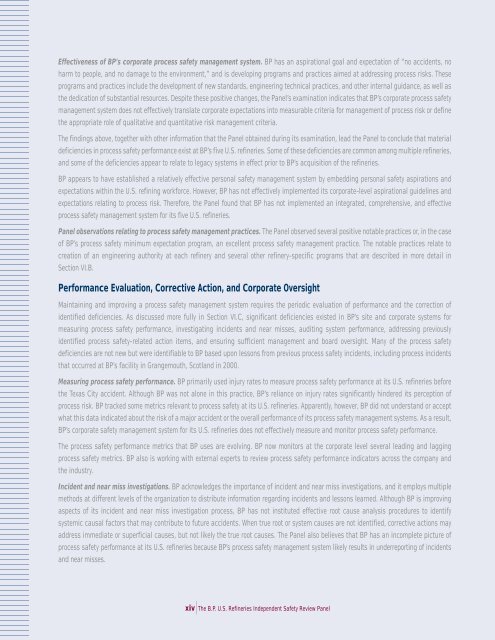The Baker Panel Report - ABSA
The Baker Panel Report - ABSA
The Baker Panel Report - ABSA
You also want an ePaper? Increase the reach of your titles
YUMPU automatically turns print PDFs into web optimized ePapers that Google loves.
Effectiveness of BP’s corporate process safety management system. BP has an aspirational goal and expectation of “no accidents, noharm to people, and no damage to the environment,” and is developing programs and practices aimed at addressing process risks. <strong>The</strong>seprograms and practices include the development of new standards, engineering technical practices, and other internal guidance, as well asthe dedication of substantial resources. Despite these positive changes, the <strong>Panel</strong>’s examination indicates that BP’s corporate process safetymanagement system does not effectively translate corporate expectations into measurable criteria for management of process risk or definethe appropriate role of qualitative and quantitative risk management criteria.<strong>The</strong> findings above, together with other information that the <strong>Panel</strong> obtained during its examination, lead the <strong>Panel</strong> to conclude that materialdeficiencies in process safety performance exist at BP’s five U.S. refineries. Some of these deficiencies are common among multiple refineries,and some of the deficiencies appear to relate to legacy systems in effect prior to BP’s acquisition of the refineries.BP appears to have established a relatively effective personal safety management system by embedding personal safety aspirations andexpectations within the U.S. refining workforce. However, BP has not effectively implemented its corporate-level aspirational guidelines andexpectations relating to process risk. <strong>The</strong>refore, the <strong>Panel</strong> found that BP has not implemented an integrated, comprehensive, and effectiveprocess safety management system for its five U.S. refineries.<strong>Panel</strong> observations relating to process safety management practices. <strong>The</strong> <strong>Panel</strong> observed several positive notable practices or, in the caseof BP’s process safety minimum expectation program, an excellent process safety management practice. <strong>The</strong> notable practices relate tocreation of an engineering authority at each refinery and several other refinery-specific programs that are described in more detail inSection VI.B.Performance Evaluation, Corrective Action, and Corporate OversightMaintaining and improving a process safety management system requires the periodic evaluation of performance and the correction ofidentified deficiencies. As discussed more fully in Section VI.C, significant deficiencies existed in BP’s site and corporate systems formeasuring process safety performance, investigating incidents and near misses, auditing system performance, addressing previouslyidentified process safety-related action items, and ensuring sufficient management and board oversight. Many of the process safetydeficiencies are not new but were identifiable to BP based upon lessons from previous process safety incidents, including process incidentsthat occurred at BP’s facility in Grangemouth, Scotland in 2000.Measuring process safety performance. BP primarily used injury rates to measure process safety performance at its U.S. refineries beforethe Texas City accident. Although BP was not alone in this practice, BP’s reliance on injury rates significantly hindered its perception ofprocess risk. BP tracked some metrics relevant to process safety at its U.S. refineries. Apparently, however, BP did not understand or acceptwhat this data indicated about the risk of a major accident or the overall performance of its process safety management systems. As a result,BP’s corporate safety management system for its U.S. refineries does not effectively measure and monitor process safety performance.<strong>The</strong> process safety performance metrics that BP uses are evolving. BP now monitors at the corporate level several leading and laggingprocess safety metrics. BP also is working with external experts to review process safety performance indicators across the company andthe industry.Incident and near miss investigations. BP acknowledges the importance of incident and near miss investigations, and it employs multiplemethods at different levels of the organization to distribute information regarding incidents and lessons learned. Although BP is improvingaspects of its incident and near miss investigation process, BP has not instituted effective root cause analysis procedures to identifysystemic causal factors that may contribute to future accidents. When true root or system causes are not identified, corrective actions mayaddress immediate or superficial causes, but not likely the true root causes. <strong>The</strong> <strong>Panel</strong> also believes that BP has an incomplete picture ofprocess safety performance at its U.S. refineries because BP’s process safety management system likely results in underreporting of incidentsand near misses.xiv <strong>The</strong> B.P. U.S. Refineries Independent Safety Review <strong>Panel</strong>

















